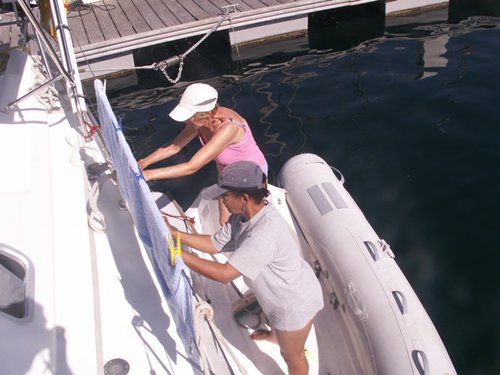Getting to the Start Line

|
28:07.6N 15:25.6W As we
headed for An
autopilot tries to make the boat go in a certain direction regardless of where
the wind is coming from. Every time the wind shifts you have to adjust your
sails but you still go in the same
direction. A
hydrovane tries to make the boat sail at a constant direction to the wind. So if
the wind shifts the boat points in a different direction but you don’t have to
keep adjusting your sails. After
half an hour of experimenting we had the boat sailing at 40 degrees to the wind
for hours on end without touching anything. It worked perfectly and will be a
great help when crossing the
The
other thing that we hadn’t got around to was the tinned food. At some point on
the big crossing the fresh food was going to run out and we would have to resort
to tins. Time to experiment and try and come up with something
edible.
The
first night passed without incident and next day we had the final flag change as
we re-entered Spanish waters
The
threatened storm never materialised. We entered the second night and the wind
died completely. This was more like the Mediterranean than the We spent the last 2 nights with really clear skies and spent hours identifying many of the 57 navigable stars. That should prove useful when the skipper whips out his sextant. Pat can now distinguish between Rigel, Capella and Aldebaran to name but a few.
Meanwhile Barrie was practicing his Spanish. La cuenta s'il vous plait was soon tripping off his tongue. At
0420 on the final morning Barrie and Margery passed an historic moment. They
were still speaking to each other! No
actually they had racked up some 2,000 nautical miles since joining the boat in
Gran
Canaria finally became visible at dawn and we were just changing shifts when a
sperm whale cruised past the yacht within about 100 metres. It was heading north
and we were heading south. By the time we had located cameras it was too far
away to photograph but we watched its blows getting further and further away.
Magic moment.
A
couple of hours later Las Palmas came into view – not pretty after some of our
idyllic stops - but we had finally arrived at the start line for our Atlantic
crossing.
We
got through all the official red tape and tied up in the marina at 1315 on
October 2nd. That was it – we were there some 2,500 miles since leaving
We
sat on the boat and all looked at each other. What now? We tried to sum up how
we felt. Paul
felt a sense of anti-climax. The journey was much more important than the
arrival. Pat
couldn’t believe she had done it without screaming and wanting to get off the
boat. Margery couldn’t immediately put into words what she felt
– but I think it was a significant It
had been a challenge for all the crew. They all rose to the challenge admirably
and the skipper is hugely grateful for all their support and for putting up with
all of his bad habits. We all learned something about ourselves. The most
important one being that we can all laugh at
ourselves. But
at the end of a long trip there is always work to be done. So we all got
busy.
And
that was it – time to pay a short visit back to the
|









